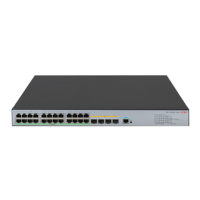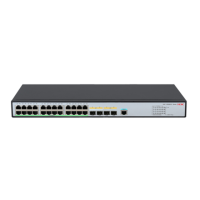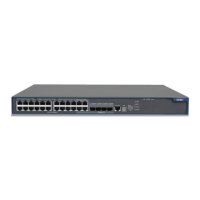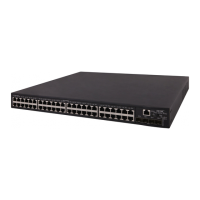27
Configuring a distributed VXLAN IP gateway
Configuration restrictions and guidelines
Make sure a VSI interface uses the same MAC address to provide service on distributed VXLAN IP
gateways connected to IPv4 sites. Make sure a VSI interface uses different link-local addresses to
provide service on distributed VXLAN IP gateways connected to both IPv4 and IPv6 sites.
If both ARP flood suppression and local proxy ARP are enabled on a distributed VXLAN IP gateway,
only local proxy ARP takes effect. As a best practice, do not use these features together on
distributed VXLAN IP gateways. For more information about ARP flood suppression, see "Enabling
ARP
flood suppression."
Configuration prerequisites
For a VXLAN that requires access to the external network, configure a static route to specify the
VXLAN's VSI interface on the border gateway as the next hop.
Configuration procedure
Step Command Remarks
1. Enter system view.
system-view
N/A
2. Create a VSI interface
and enter VSI interface
view.
interface vsi-interface
vsi-interface-id
By default, no VSI interfaces exist.
3. Assign an IPv4 or IPv6
address to the VSI
interface.
• Assign an IPv4
address:
ip address ip-address
{ mask | mask-length }
[ sub ]
• Assign an IPv6
address:
See IPv6 basics in
Layer 3—IP Services
Configuration Guide.
By default, no IPv4 or IPv6 address is
assigned to a VSI interface.
This interface will be used as a gateway for
VXLANs.
4. Specify the VSI
interface as a
distributed gateway.
distributed-gateway local
By default, a VSI interface is not a distributed
gateway.
5. Enable local proxy ARP
or local ND proxy.
• Enable local proxy ARP
on an IPv4 gateway:
local-proxy-arp
enable [ ip-range
startIP to endIP ]
• Enable local ND proxy
on an IPv6 gateway:
local-proxy-nd enable
By default, local proxy ARP and local ND
proxy are disabled.
For more information about the commands,
see Layer 3—IP Services Command
Reference.
6. Return to system view.
quit
N/A

